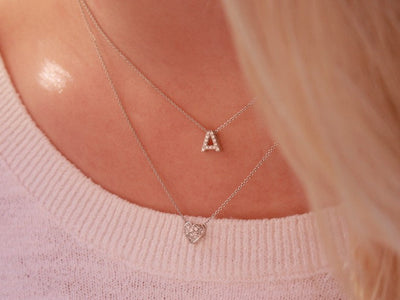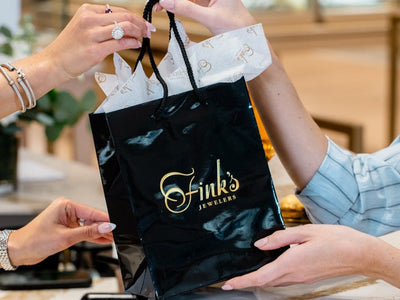There’s nothing quite as exciting as shopping for the perfect engagement ring. Even when you think you know what you’re looking for, stepping into a store full of brilliant diamond rings can take your breath away. Suddenly, being surrounded by the sparkle of gorgeous options may have you a bit curious. With an enormous variety of engagement rings before you, choosing the perfect cut or setting may take more time than you thought. And this is where we love to assist! Allow us to give you a peek at our finest engagement rings and some helpful tips on selecting the very best stone for your diamond ring.
How Do You Find an Engagement Ring That Represents You?
Your engagement ring will sparkle on your finger forever, so selecting the diamond ring that you’ll look upon for years is an important decision. Have you already considered your style, taste, and preferences? No worries if you’re feeling a tad overwhelmed. Our knowledgeable engagement experts have put together a few suggestions that have helped many couples determine their dream ring. From round diamond rings to marquise cut, here are a few things to consider.
What is the Best Metal for an Engagement Ring?
When choosing the metal for your engagement ring, consider what your eye is typically drawn to. Do you tend to choose gold jewelry, or does your skin tone look radiant in silver settings? Diamond rings are spectacular in any metal, from rose gold to platinum, but it all comes down to the look of the diamond ring you envision on your finger forever. And if you're still unsure about the metal that is meant for your ring finger, just enjoy trying them all on! The right one will reveal itself. It always does. Consider one of our favorites:
- The Studio Collection Oval Diamond Double Halo Split Shank Engagement Ring. This rose gold oval diamond ring beauty shows off a .50ct diamond with a double diamond halo with diamond shank accents. It’s flattering on any skin tone.
- The Studio Collection Round Diamond Halo and Classic Shank Engagement Ring. This 14K white gold diamond ring is beautifully designed with a diamond halo.
- The Studio Collection Trellis Round Diamond Engagement Ring. Feast your eyes on this precious round solitaire diamond paired perfectly with 18K yellow gold and platinum.
Choosing the Perfect Setting
Are you a solitaire girl? Do round diamond rings catch your eye? Does your heart stop at the sight of a brilliant stone at the center of beautiful accent stones? Selecting the setting of your engagement ring doesn’t need to feel overwhelming. After perching a few on your finger, you’ll begin to narrow down the styles that make your heart flutter. And when you can't take your eyes off of one in particular, you'll know you've fallen in love again. You may just fall for a few of our favorite engagement rings with breathtaking settings:
- The Studio Collection Emerald and Baguette Diamond Engagement Ring. A stunning three-stone diamond ring that’s sure to make you the envy of all. The center stone is a dazzling emerald cut with two perfect .15ct baguettes to accent.
- The Studio Collection Round Diamond Center Stone Pavé Shank Engagement Ring. Our gorgeous round diamond ring features .28cttw pave’ diamonds that anyone would love.
Deciding on the Center Stone’s Cut for Your Engagement Ring
If you haven’t already been dreaming of a princess cut or eyeing an emerald solitaire, you may enjoy this part the most — at least we do! If you’re looking for something beyond the traditional round diamond ring, here’s an option we can’t wait for you to admire:
- Fink's Exclusive Platinum Pear Shape Diamond Halo Engagement Ring: There are so many reasons this is one of our top ten favorites. The pear cut diamond offers an eye-catching uniqueness, while the halo design is always a favorite. Adding to the appeal is the diamond-accented platinum band.
What Should I Look For When Diamond Ring Shopping?
How familiar are you with the 4Cs of diamonds? Before you head out to select an engagement ring, arm yourself with the ins and outs. The 4Cs are designed to provide trustworthy, reliable consistency throughout the diamond industry. Strict standards are set for:
- Clarity
- Color
- Cut
- Carat weight
This is a global grading system that ensures your diamond undergoes the same quality evaluations as all other diamond rings. At Fink’s, we even take it a step further with our five Cs of diamonds.
The Clarity of your Diamond Ring
Clarity was once described with words like perfect, near-perfect, flaws, and imperfections. Ethical guidelines take away the subjective labels so you can determine the clarity of your diamond ring purchase. And so, the GIA Clarity Scale was created.
Tiny imperfections, or inclusions, are found inside virtually all diamonds. As you select your stone for your diamond ring, notice the blemishes on the surface of each diamond. The intense pressure and heat a stone experiences when formed may create these blemishes.
Several factors determine the grading of diamonds for clarity. When stones are placed under 10x magnification, the size, location, and number of surface imperfections can be seen and noted.
The Clarity Scale consists of grades and categories in which the diamonds are placed, as determined by their blemishes or inclusions found. The Clarity Scale creates ethical precision through the use of the following six categories:
- Flawless
- Internally flawless
- Very very slightly included
- Very slightly included
- Slightly included
- Included
Here at Fink’s Jewelers, we pride ourselves on only offering stones that do not possess inclusions that are visibly apparent to the naked eye. Rest assured, any Fink’s Diamond you choose for your diamond ring meets each of our Superior Quality® standards.
The clarity grading provides a precise way for each customer to recognize a diamond's imperfections and make their selections accordingly. We accredit our expertly chosen, fine quality stones to Clif. Clif inspects every diamond under a gemological microscope himself. Through years of experience, he knows exactly how to spot all imperfections and makes sure you only have the highest-quality diamonds to select from for your perfect engagement ring.
What Identifying Marks Determine Clarity?
- Large feathers, or cracks - Take time to look for feathers in the stones you are considering. These feathers can be seen by the naked eye and typically appear as a white area.
- Dark inclusion - These dark areas are carbon spots that have not appropriately crystalized. You’ll recognize them as small black specks.
- Reflectors - Mirrored images of inclusions. During the diamond’s polishing process, large indented cavities may be created. If there is a feather near the surface of the stone, a tiny opening, or cavity, may be created.
- Knots - On the surface of a stone, you may also notice tiny knots. These can be seen with the naked eye.
How is the Color of a Diamond Rated?
Before the creation of the 4Cs, shopping for a diamond left buyers relying on the honesty of the merchants. The color of stones was often categorized as A, AA, or AAA, yet lacked concrete guidelines. Assigning a diamond to any one of these color categories was typically subjective and often unethical.
The GIA began to develop an objective color-grading system around the 1930s. It wasn’t until 1953 that the GIA D-to-Z Color Scale was revealed. Accompanying this scale were exact methods to be followed to ensure rating the color of the stone was consistent and reliable.
You’ll find stones for your diamond ring in a wide range of colors. Keep in mind, even the slightest difference between two similar stones can reflect an enormous difference in its quality and price tag. To the naked eye, a variation in color may not be as noticeable. The ability to rely on the color-grading scale offers buyers like yourself peace of mind.
While you may be admiring a variety of diamond rings after the stone is already in its setting, it is ideal to examine a stone when it is loose. Setting colors may reflect upon and change the actual color of the stone. There are other factors to keep in mind when evaluating color, including:
- Lighting used to examine the stone
- The background color used to assess the diamond may cause slight variations in the stone’s color
- The size of the stone itself could also be a determining factor
We want you to feel 100% confident about the superior color of any diamond you choose for your engagement ring. At Fink’s Jewelers, you’ll only be presented with stones in our Superior Quality® color range, D-to-K. These diamond grades are assigned to colorless diamonds, which are the highest grades available, as determined by the GIA.
Choosing a Flattering Cut for Your Engagement Ring
The cut of a diamond is so much more than choosing between a round diamond ring or emerald cut. Through the use of computer modeling, an accurate grading system was able to be developed. This grading system includes five grades you should be informed of before your search begins. These are:
- Excellent
- Very good
- Good
- Fair
- Poor
Ultimately, the cut of a stone is what will determine how a diamond will “perform.” When a diamond "performs" well, it is primarily due to its symmetry, proportions, and polish.
This makes the cut a vital determining factor. The cut will determine the:
- Brilliance of the diamond’s sparkle
- Reflection of light from the stone
- The overall visual appearance of the diamond’s size
The cut of each stone is carefully considered here at Fink’s. We believe in the artform of perfecting the cut of a diamond to ensure the value it brings to the stone. It's an incredible skill that requires years to develop, and we take this seriously. When a diamond’s cut is evaluated for Fink’s selection, we inspect the way it interacts with light. Take note of this when you evaluate your stones. Keep an eye on its symmetry. Symmetrical diamonds will exceed your expectations with a radiant sparkle when it reflects light accurately. Well-cut stones capture and reflect light brilliantly, while a poorly cut stone may have a dull, unappealing look to it.
Clif considers all factors when he inspects a stone. A Fink’s diamond must be evaluated carefully, searching for only perfectly cut proportions. Each diamond undergoes this evaluation process for ideal symmetry to meet our Superior Cut® standards. When the cut of a stone is too shallow or deep, its brilliance is affected. This will also affect its value. We have no doubt you’ll take one look at our diamond ring selection and know they sparkle beyond any other in comparison.
Valuing the Weight of the Carat
The carat of each stone refers to the weight of a diamond. It’s easy to mistake the term carat weight for its size. The cut of a stone can also play a significant role in the overall appearance of its size.
Here’s how carat weight is determined:
- A metric carat weight is defined as 200 milligrams
- Each carat is subdivided into 100 points
- A Jeweler’s measurements can then be precise; down to the hundredth decimal
The value of a diamond does increase with its carat weight. But ultimately, it's determined by the combination of all 4Cs.
Now that we’ve filled your mind with knowledge and provided our favorite eye candy, it’s time to find your ring. Stop by one of our Fink’s locations, and let us help you choose the engagement ring of your dreams.











